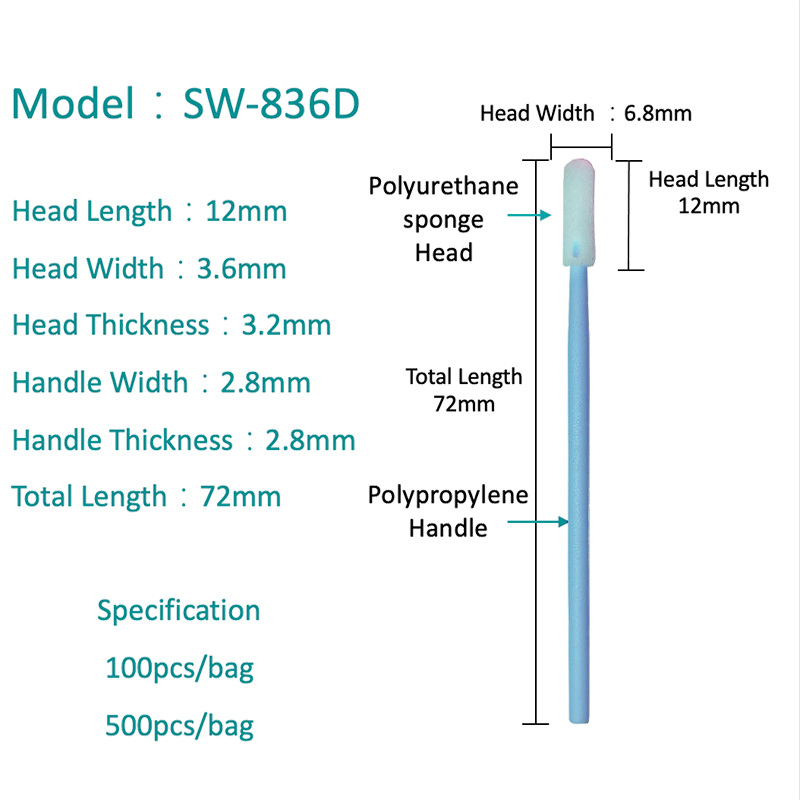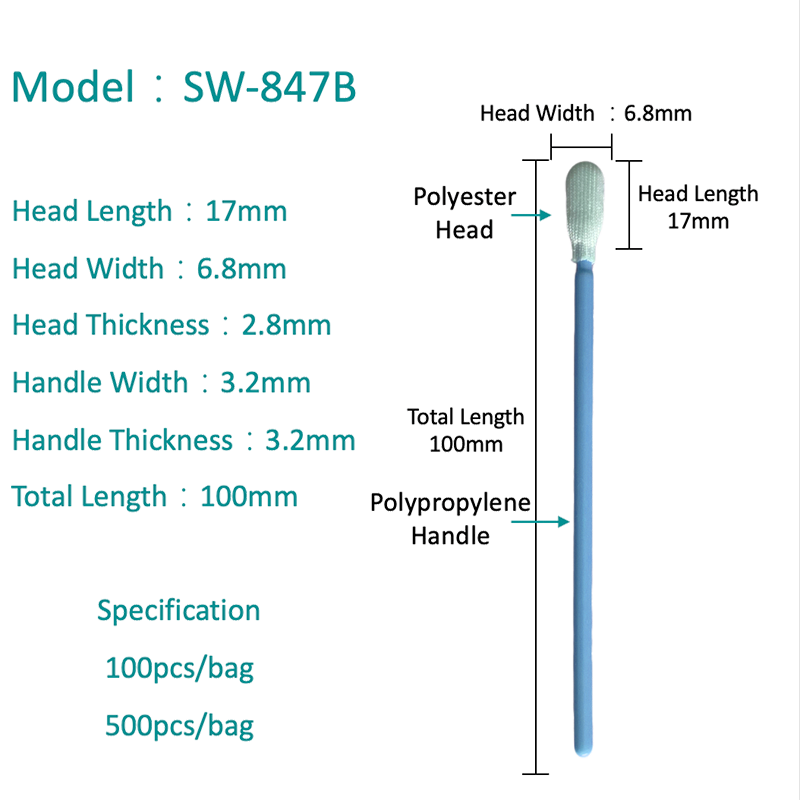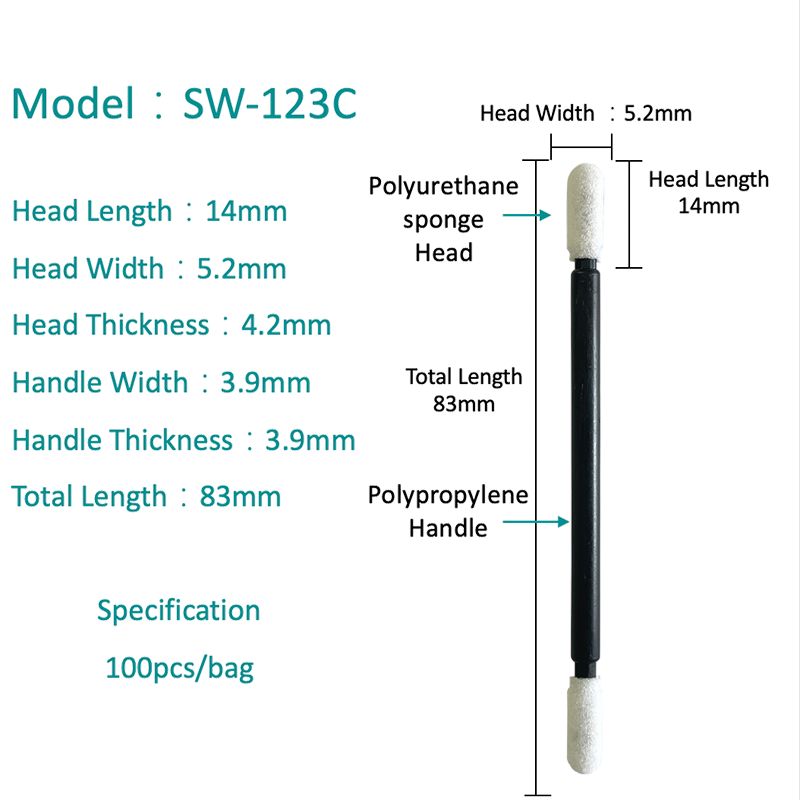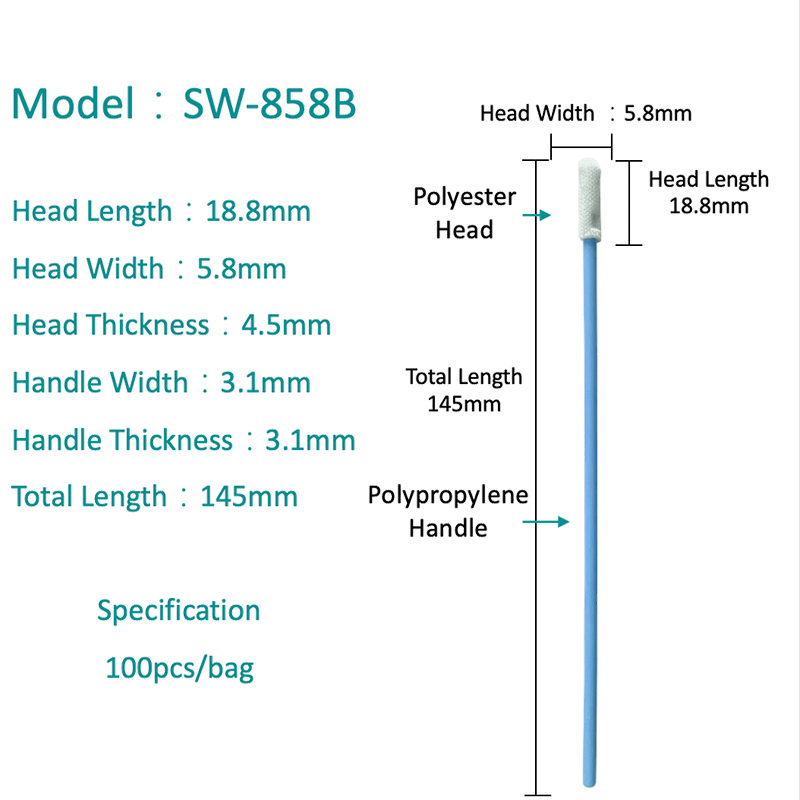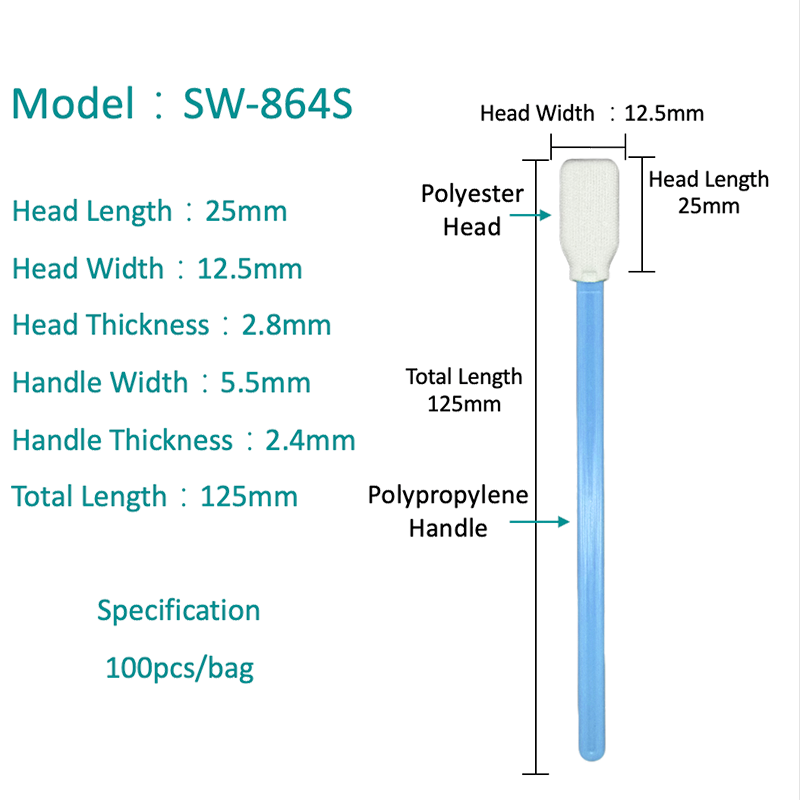HOME / NEWS / Industry News / The Ultimate Guide to Sterile Foam Swabs: Selection, Applications, and Best Practices
What are Sterile Foam Swabs and Their Primary Uses?
Sterile foam swabs represent a critical category of cleaning and application tools designed for precision tasks where contamination control is paramount. Unlike common cotton swabs, these instruments feature a head made from specialized open-cell polyurethane foam, which is mounted on a sturdy handle, often made of plastic or paper. The entire unit is sterilized, typically using gamma irradiation or ethylene oxide gas, to achieve a specific Sterility Assurance Level (SAL), making them suitable for use in environments where even microscopic contaminants can cause significant issues. The primary value proposition of a sterile foam swab lies in its ability to perform delicate tasks without introducing new contaminants or leaving behind particulate residue, a common drawback of traditional fibrous materials.
Defining Characteristics and Construction
The effectiveness of a sterile foam swab is determined by its material properties and manufacturing process. The foam head is engineered to be highly absorbent yet non-abrasive, ensuring it can effectively capture and retain contaminants without scratching sensitive surfaces. The open-cell structure allows for exceptional liquid retention, which is crucial for applying precise amounts of solvents, reagents, or lubricants. Furthermore, the foam is manufactured to be low in extractables, meaning it won't leach chemicals that could interfere with sensitive processes. The handles are designed for ergonomic control, often with a tapered tip for accessing confined spaces. This combination of features makes them indispensable in fields that demand the highest levels of cleanliness and precision.
Core Industries and Applications
The application spectrum for sterile foam swabs is vast and crosses multiple high-stakes industries. Their use is non-negotiable in scenarios where a single particle or microbial cell can lead to catastrophic failure or compromise.
- Electronics Manufacturing and Aerospace: For cleaning and flux removal on printed circuit boards (PCBs), optical components, and delicate sensors without generating static electricity or lint.
- Pharmaceutical and Biotechnology: Used in aseptic processing to clean equipment, apply solutions, and sample surfaces for environmental monitoring within cleanrooms.
- Medical Device Manufacturing and Healthcare: Application of antiseptics, handling of tissue samples, and cleaning of surgical instruments or diagnostic equipment.
- Laboratory Research: Precise handling and application of biological samples, cell cultures, and reagents where contamination must be avoided.
The versatility of these tools is further enhanced by the availability of various shapes (e.g., spears, paddles, tips) and sizes, each tailored for a specific type of task and access requirement.
Key Advantages of Using Sterile Foam Swabs Over Alternatives
When selecting a tool for critical cleaning and application, professionals often evaluate alternatives like sterile cotton swabs, polyester swabs, or even non-woven wipes. However, sterile foam swabs consistently demonstrate superior performance in several key areas, justifying their specification in stringent protocols.
Superior Cleaning and Absorption Capability
The open-cell foam structure provides a much larger internal surface area for absorption compared to the fibrous structure of cotton. This allows the swab to hold more liquid and effectively trap contaminants within the foam matrix, rather than just pushing them around on the surface. This is crucial for removing ionic contamination from electronics or biological residues from medical devices. For instance, when used with isopropyl alcohol, a foam swab will consistently remove more particulate matter from a surface than a cotton swab used with the same solvent, due to its superior trapping mechanism and lack of fiber shedding.
Minimal Particle Generation and Linting
This is arguably the most significant advantage. Cotton and other woven materials are notorious for shedding microfibers (lint), which can become a catastrophic contaminant on an optical lens, a microchip, or within a fluidic pathway. Sterile foam swabs, particularly those made from high-quality, thermally bonded polyurethane, are designed to be virtually lint-free. This ensures that the cleaning process itself does not become a source of contamination, a critical requirement in ISO Class 5 cleanrooms and other controlled environments.
Chemical Compatibility and Low Extractables
High-performance sterile foam swabs are engineered to be chemically compatible with a wide range of solvents, acids, alkalis, and other processing chemicals without breaking down. More importantly, they are manufactured and purified to have very low levels of extractable materials. This means that when a solvent is applied using the swab, the risk of the swab leaching plasticizers, dyes, or other impurities into the process is minimized. Cotton swabs, in contrast, often contain natural oils and processing chemicals that can be extracted by aggressive solvents, potentially leaving behind a film or causing chemical interference.
Comparison Table: Foam vs. Cotton Swabs
The following table summarizes the critical differences between sterile foam swabs and sterile cotton swabs, highlighting the performance advantages of foam in technical applications.
| Feature | Sterile Foam Swab | Sterile Cotton Swab |
|---|---|---|
| Linting / Particulate Generation | Very Low (Virtually Lint-Free) | High (Significant Linting) |
| Absorbency Capacity | Very High (Open-Cell Structure) | Moderate (Fibrous Structure) |
| Chemical Resistance | High (Compatible with many solvents) | Low (Fibers can break down) |
| Risk of Extractables | Low | Moderate to High (Natural oils) |
| Abrasion on Sensitive Surfaces | Low (Soft, non-abrasive foam) | Moderate (Can be abrasive) |
| Best Suited For | Critical cleaning, precision application, electronics, aerospace, pharmaceuticals. | General purpose wiping, first aid, non-critical applications. |
How to Choose the Right Sterile Foam Swab for Your Needs
Selecting the appropriate sterile foam swab for sensitive surface cleaning is not a one-size-fits-all decision. A swab that is perfect for applying solvent to a connector may be entirely wrong for sampling the inner surface of a tube. The selection process requires a careful evaluation of the application's specific requirements to ensure optimal performance and avoid introducing risk.
Understanding Foam Density and Pore Size
The physical properties of the foam itself are the primary differentiators. Two key properties are density and pore size, which directly influence absorbency, softness, and abrasiveness.
- Low-Density, Large-Pore Foam: This type is highly absorbent and very soft, making it ideal for tasks like applying a large volume of liquid or cleaning a highly delicate, flat surface without scratching. However, it may lack the mechanical strength for aggressive scrubbing.
- High-Density, Small-Pore Foam: This foam is more rigid and durable, offering better mechanical action for dislodging stubborn contaminants. It provides less absorbency but greater control and is excellent for cleaning irregular surfaces or reaching into crevices. The choice depends entirely on whether the priority is maximum fluid delivery or mechanical cleaning action.
Selecting the Appropriate Swab Tip Configuration
The shape of the swab tip is critical for accessing the target area effectively. Using the wrong tip shape can result in ineffective cleaning and potential damage.
- Pointed Tip (Spear): Designed for precision work, accessing small holes, slots, and tight corners. Ideal for cleaning around component leads on circuit boards or specific areas on a medical device.
- Flat Edge (Paddle): Provides a broad, flat surface for wiping large, flat areas efficiently. Excellent for cleaning optics, display screens, or large flat surfaces in cleanroom equipment.
- Tapered Tip: Offers a versatile shape that combines a pointed end for precision with a broader base for wider coverage. A good general-purpose choice for varied tasks.
For those working with very specific and constrained geometries, finding the right sterile foam swab for precision application in electronics means prioritizing a tip shape that matches the component layout without causing accidental contact with adjacent parts.
Evaluating Sterilization Method and Packaging
The "sterile" claim must be validated by understanding the sterilization method and its implications. Gamma irradiation is a common and effective method that penetrates deeply through packaging but can slightly alter the physical properties of some plastics. Ethylene Oxide (EtO) is another method that is effective for heat-sensitive materials but requires aeration to remove gas residues. The chosen method should be compatible with the swab's materials and the intended application. Furthermore, packaging should be a validated sterile barrier system, often a durable, sealed pouch that maintains sterility until the moment of use. For tasks like cleaning sensitive medical equipment with foam swabs, the sterility certificate and the integrity of the packaging are as important as the swab itself.
Best Practices for Using Sterile Foam Swabs Effectively
To maximize the value and performance of sterile foam swabs, users must adhere to a set of best practices that govern their handling and application. Improper use can negate the benefits of the swab and even become a source of contamination. This is especially true for a task like applying solvent with a sterile foam tip applicator, where technique directly impacts outcome.
Proper Aseptic Handling Techniques
Maintaining the sterility of the swab from package opening to disposal is the foremost concern. The technique must prevent the swab head or handle from contacting any non-sterile surface.
- Inspect the packaging for any damage, tears, or punctures before use. Do not use if the package integrity is compromised.
- Open the package carefully by tearing at the notched end, pulling the sides apart to allow the swab to be removed without touching the outside of the pouch or any other surface.
- Hold the swab only by the handle, keeping the foam head pointed downward to minimize the risk of airborne contamination settling on it.
- Use the swab immediately after opening. Do not place it down on a surface or wave it around.
- Use a single swab per application or surface to avoid cross-contamination. Never re-dip a used swab into a clean solvent or solution container.
Optimal Application and Cleaning Methods
The technique used to wipe or apply liquid significantly affects results. The goal is to achieve maximum contaminant removal with minimal swab pressure.
- Wetting: For cleaning, apply an appropriate solvent to the swab head. It should be damp but not dripping wet. An oversaturated swab can cause the solvent to flow into areas where it is not intended, potentially causing damage.
- Wiping Motion: Use a systematic, overlapping wipe pattern. For flat surfaces, use a unidirectional motion (e.g., left to right, top to bottom) rather than a circular motion, which can re-deposit contaminants. Turn the swab to a clean side after each pass.
- Pressure: Apply gentle, consistent pressure. Excessive force can shred the foam, damage the surface, and trap particles deeper into irregularities on the substrate. Let the solvent and the foam's absorbency do the work.
- For application tasks, gently daub or roll the swab to transfer liquid evenly and precisely without splashing.
Following these protocols ensures that the benefits of non-abrasive foam swabs are fully realized, protecting both the component being cleaned and the integrity of the process.
Specialized Applications: Beyond Basic Cleaning
While cleaning is a primary function, the unique properties of sterile foam swabs make them the tool of choice for several highly specialized applications that go far beyond simple wiping. These uses leverage their precision, absorbency, and cleanliness in innovative ways.
Environmental Monitoring and Surface Sampling
In pharmaceutical and medical device cleanrooms, regular monitoring for microbial and particulate contamination is mandated by regulations. Sterile foam swabs are perfectly suited for this. A swab, often moistened with a neutralizer solution, is used to methodically sample a defined surface area (e.g., 25 cm² by 25 cm²). The large absorbent capacity allows it to effectively pick up any microbial contaminants present on the surface. After sampling, the swab head is either placed into a tube of recovery media and agitated to release organisms for analysis or directly plated onto agar. The swab's low particulate generation is critical here to avoid false positives in the particle count analysis.
Precision Application of Coatings and Lubricants
In aerospace and precision engineering, there is often a need to apply minute amounts of specialty lubricants, conductive coatings, or adhesives to specific locations on a component. The controlled absorbency of a foam swab allows a technician to pick up a precise volume of material and apply it exactly where needed without overflow or mess. For example, applying a tiny amount of dielectric grease to a connector pin or a specific lubricant to a miniature hinge mechanism. The foam ensures an even, controlled transfer that brushes or other tools cannot match.
Handling and Manipulating Delicate Components
The soft, non-abrasive nature of foam makes these swabs excellent tools for gently manipulating tiny, fragile components under a microscope. The foam tip can be used to nudge a component into place, hold it steady, or clean it in situ without the risk of scratching or electrostatic discharge that metal tools might pose. This application is common in microelectronics assembly, laboratory research involving small samples, and the repair of delicate instruments.
In conclusion, the sterile foam swab is a deceptively simple tool whose value is unlocked through informed selection and meticulous use. By understanding its properties, advantages, and the best practices for its application, professionals across critical industries can ensure they are achieving the highest possible standards of cleanliness and precision in their work.




 English
English  中文简体
中文简体 

